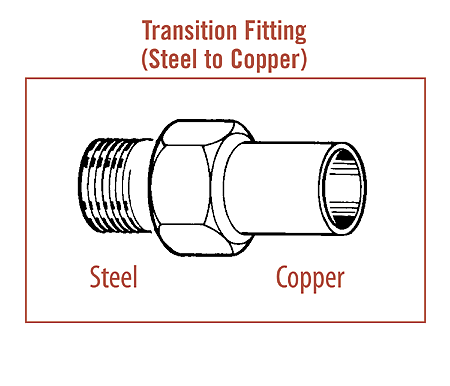
Last month we looked at the most basic shapes and functions of supply fittings, giving examples that apply to most types of piping systems. In addition to those, we want to add a few specialty types in which functions are combined. Take reducers, for example - the ones used to connect two different pipe diameters. This function is also applied to many of the other fittings discussed - thus there are reducing elbows, reducing tees, reducing wyes and reducing crosses.
Similarly, with the union function, you have union elbows and union tees. There are unions with one male connection and one female. And there are elbows and return bends with side outlets (the tee function). If there is a need to combine functions into a single fitting, chances are that somebody, somewhere, makes exactly what you need. Check it out. (Note: Not all of the specialty fitting configurations are available for all piping material systems. The examples just given relate primarily to the metal options.)
SPECIFYING THE RIGHT KIND OF FITTINGS
Now that we have looked at what most supply fittings have in common - their configurations and functions - let's move on to examine the differences related to specific piping materials and connection systems. In other words, "how do you know what to use with what?"Piping Material: When it comes to specifying appropriate fittings, the first and most basic matter concerns the piping material for which the fittings are to be used. The common options such as steel, copper, PVC and PEX all have their unique types, specifically designed for use with that system. It is important to understand that most types of fittings are not interchangeable between systems. In other words, fittings designed for use with steel piping are not usable with copper tube systems, and vice versa (except in the case of certain "transition" or "adapter" types of fittings, which we'll cover later).
Weight Grade: In terms of strength, the fittings used must have a pressure capability appropriate for the piping material being used. As an example, if the basic piping system involved is "double extra strong steel," you would want to be certain that the fittings used are strong enough to match the pressure capability of that system. The method of identifying pressure grades of fittings varies from one system to another. With some, the identification is essentially the same as the pipe with which it is used (for plastic piping-Schedule 40, Schedule 80, etc.). With others, the classes are identified according to pressure rating (class 150, class 300, etc.).
System of Connection: Once you have determined the basic type and weight grade of the piping system, the next consideration is the means of connection involved. If the system is to be "Type M" copper, for instance, that still doesn't give you all the information you need in order to specify the fittings. What method of connection will be used? Sweat (soldered or brazed)? Flare? Compression?
Similarly, there are alternate considerations related to the joining of other piping materials. Steel pipe can be screwed or welded. PEX can be joined by insert fittings or the compression type.
Variations in Material Makeup: The material and process employed to make the fittings is primarily a consideration related to metal piping systems. Fittings for plastic piping, on the other hand, frequently employ the use of a material identical to the piping itself (insert fittings used with flexible materials being a notable exception). In applying this consideration to metal piping, it is important to understand that this subject often goes hand-in-hand with the piping weight class and pressure criteria already discussed. Many times, when a fitting with a higher-than-normal pressure capability is required, it is necessary to select a different specific fitting material than that which is normally used. Using a steel piping system as an example, specification of malleable iron rather than cast iron supply fittings automatically means that you are selecting a variety with a greater pressure capability. Then, within the specific category of malleable iron fittings, you would further identify the desired strength according to the pressure classes available.
There is a parallel situation in the case of fittings used with copper piping systems. In this instance, you have the option of products made of wrought or cast copper, as well as varieties made of brass and bronze. One of these specific materials would be selected on the basis of the type of copper tube being used, together with the pressure requirements involved.
Finishes or Coatings: This is another consideration that relates primarily to fittings used with metal piping systems. In the case of those used with steel piping, for instance, there are options of plain (also called "black" or "unfinished") or galvanized. In addition, certain steel fittings are sometimes specified with a chrome-plated finish (usually for applications where they would be exposed to view, or where sanitation or corrosion resistance would be factors).
TRANSITION (ADAPTER) FITTINGS
While it ordinarily isn't possible to use the fittings from one system to join directly to another, almost all systems include fittings that make the transition. Not too surprisingly, these are called "transition" fittings (also called adapters).As an example, there are fittings that have female steel pipe threads on one end, and a female copper tube socket on the other. Others join threaded steel on one end, to solvent welded pipe on the other. Still more examples include fittings that join flexible plastic piping material (PEX, for instance) to threaded steel, and compression copper to sweat copper.
Using such fittings, it is possible to use more than one type of piping material in the same overall system. If you wished to make a plastic piping branch line off an existing steel one, for instance, you would come off the main run with a steel-to-plastic transition fitting. From that point, all the pipe sections and fittings in your branch run would be plastic.
